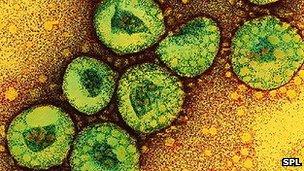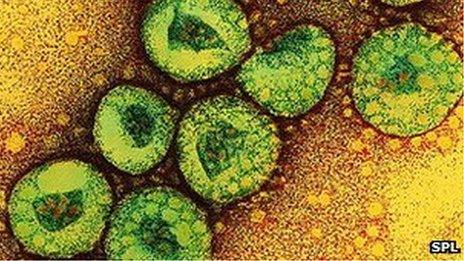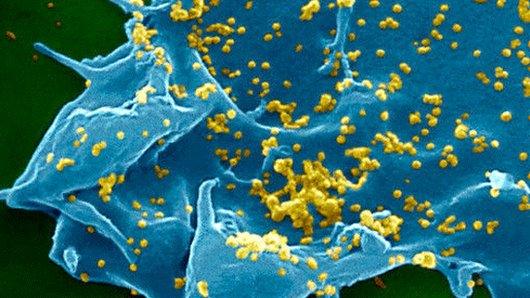Threat from novel coronavirus 'remains low'
- Published
- comments

Scientists want to know the origin of the coronavirus infection
The emergence of the novel coronavirus is a reminder of the potential threat we face from emerging diseases. A decade ago hundreds of people were killed by severe acute respiratory syndrome (SARS).
Although the novel coronavirus is from the same large family of pathogens as SARS, it is very different. And although media reports usually mentions the new virus and SARS in the same breath it is worth pointing out that coronaviruses also produce infections like the common cold.
Crucially the new virus seems hard to catch and is difficult to spread. Had it been otherwise there would have been far more cases.
The World Health Organization says there have been 34 confirmed cases since September 2012.
That does not mean the threat from this virus should be ignored. If you are unlucky enough to get infected the odds are not good. More than half the patients with confirmed infection have died and others remains seriously ill.
The respiratory illness causes pneumonia, can attack the kidneys and other organs.
'No reason to panic'
The reason why the virus is in the news is because the WHO has said there is more evidence of person-to-person transmission. A patient who was being treated for the infection in northern France appears to have passed on the virus to another man who had been sharing a hospital room with him. Both are now being cared for in isolation.
In February there was a family cluster of three cases in England. A man who had been travelling in Saudi Arabia returned to the UK and apparently passed on the infection to his son and another family member. Both he and his son died. The third member of the family recovered.
Both the French and English cases suggest the virus is not very contagious and requires close proximity. Health officials in England traced up to 100 people who had been in contact with the man who returned from the Middle East, and none apart from family members got the virus.
"We are right to be concerned about the reporting of transmission from person-to-person, but there is absolutely no reason to panic.
"The 'super-spreading' events, in which one person infects several dozen people at a time (as was seen with SARS coronavirus), do not seem to be happening with this coronavirus" said Prof Peter Openshaw, Director of the Centre for Respiratory Infection, Imperial College London.
Mystery
But that does not mean there is any room for complacency. A fourth UK case - a man who acquired the infection in the Middle East - has been in hospital in London since September. The sheer virulence of the infection, which can cause multi-organ failure, means it must be regarded a potent threat.
The virus is thought to have originated in bats, but how the initial infection gets passed to humans remains a mystery. It is probable that it has an animal source, but whether it spreads from contaminated food or something else in the environment is unknown. Until scientists can establish this route of infection they can't initiate measures to try to eradicate the virus.
"The most important goal remains to locate the source of infection so that measures to minimise contact can be taken", said Prof Ian Jones, Professor of Virology, University of Reading.
So for the moment this novel coronavirus remains a dangerous but thankfully very rare infection.
- Published12 May 2013

- Published2 July 2015
